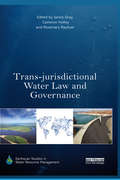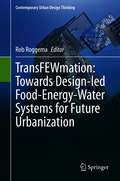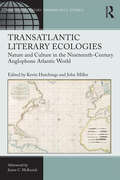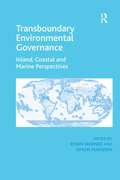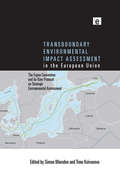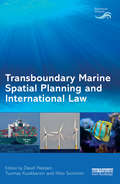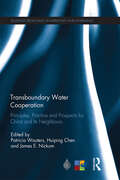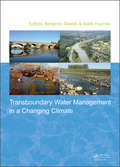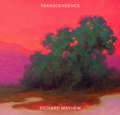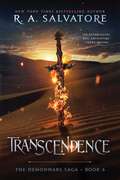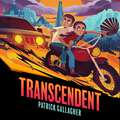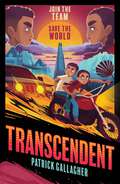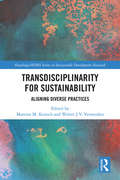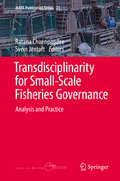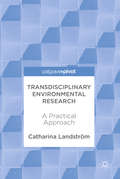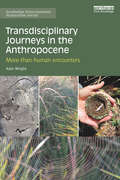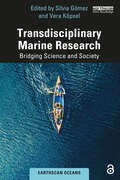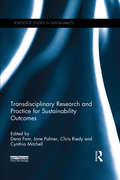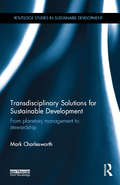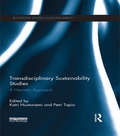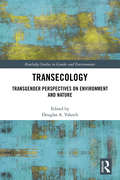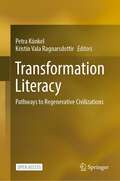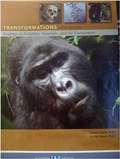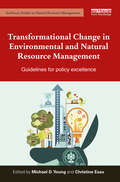- Table View
- List View
Trainstop
by Barbara LehmanA ride on the train is exciting. There’s always something new to see, even if you’ve been there before. But some train rides are better than others . . . What if a train took you somewhere else entirely? What if the doors opened in a strange, new place? This is one train stop you won’t want to miss!
Trans-jurisdictional Water Law and Governance (Earthscan Studies in Water Resource Management)
by Janice Gray Cameron Holley Rosemary RayfuseGovernance of global water resources presents one of the most confounding challenges in contemporary natural resource governance. With considerable government, citizen and financial donor attention devoted to a range of international, transnational and domestic laws and policies aimed at protecting, managing and sustainably using fresh and coastal marine water resources, this book proposes that sustainable water outcomes require a ‘trans-jurisdictional’ approach to water governance. Focusing on the concept of trans-jurisdictional water governance the book diagnoses barriers and identifies pathways to coherent and coordinated institutional arrangements between and across different bodies of laws at local, national, regional and international levels. It includes case studies from the European Union, Australia, New Zealand, South Africa, the United States and Southeast Asia. Leading specialists offer insights into the pretence and the promise of trans-jurisdictional water governance and provide readers, including students, practitioners, policy-makers and academics, with a basis for better analysing, articulating and synthesising standards of good trans-jurisdictional water governance both in theory and in practice.
TransFEWmation: Towards Design-led Food-Energy-Water Systems for Future Urbanization (Contemporary Urban Design Thinking)
by Rob RoggemaThis book discusses a spectrum of approaches to designing the food-energy-water nexus at different spatial-urban scales. The book offers a framework for working on the FEW-nexus in a design-led context and integrates the design of urban neighbourhoods and regions with methodologies how to simultaneously engaging residents and stakeholders and evaluating the propositions in a FEW-print, measuring the environmental impact of the different designs. The examples are derived from on the ground practices in Sydney, Tokyo, Detroit, Amsterdam and Belfast.
Transatlantic Literary Ecologies: Nature and Culture in the Nineteenth-Century Anglophone Atlantic World (Ashgate Series in Nineteenth-Century Transatlantic Studies)
by James C. McKusickOpening a dialogue between ecocriticism and transatlantic studies, this collection shows how the two fields inform, complement, and complicate each other. The editors situate the volume in its critical contexts by providing a detailed literary and historical overview of nineteenth-century transatlantic socioenvironmental issues involving such topics as the contemporary fur and timber trades, colonialism and agricultural "improvement," literary discourses on conservation, and the consequences of industrial capitalism, urbanization, and urban environmental activism. The chapters move from the broad to the particular, offering insights into Romanticism’s transatlantic discourses on nature and culture, examining British Victorian representations of nature in light of their reception by American writers and readers, providing in-depth analyses of literary forms such as the adventure novel, travel narratives, and theological and scientific writings, and bringing transatlantic and ecocritical perspectives to bear on classic works of nineteenth-century American literature. By opening a critical dialogue between these two vital areas of scholarship, Transatlantic Literary Ecologies demonstrates some of the key ways in which Western environmental consciousness and associated literary practices arose in the context of transatlantic literary and cultural exchanges during the long nineteenth century.
Transboundary Environmental Governance: Inland, Coastal and Marine Perspectives
by Simon MarsdenEffective protection of the marine and terrestrial environment increasingly requires cooperation between neighbouring States, international organizations, government entities and communities within States. This book analyses key aspects of transboundary environmental law and policy and their implementation in Asia, Australasia and Australian offshore territories, and surrounding areas beyond national jurisdiction including Antarctica. It discusses the potential for implementing key transboundary environmental mechanisms such as the 1991 Convention on Environmental Impact Assessment in a Transboundary Context (Espoo Convention) and its 1997 Protocol on Strategic Environmental Assessment (Kiev Protocol) in Australia and Asia drawing on experience from other regions and the potential application of these agreements to all UN member states. The book makes an innovative contribution to research in the area of transboundary environmental governance particularly as it applies to Asia, Australasia and international areas, supplementing similar research which has predominantly focused on Europe and North America.
Transboundary Environmental Impact Assessment in the European Union: The Espoo Convention and its Kiev Protocol on Strategic Environmental Assessment
by Timo Koivurova Simon MarsdenThis book examines 'The Espoo Convention on Environmental Impact Assessment in a Transboundary Context', which celebrates the twentieth anniversary of its adoption in 2011, and its 'Kiev Protocol on Strategic Environmental Assessment' which came into force in July 2010. In addition to contributing to international environmental law, the Convention has prompted significant changes to European environmental law. The chapters in this collection explain the role of transboundary environmental impact assessment in international and European law, and explore the relationship between international and European law in the context of potential application of the Convention. They also examine examples of the Convention in practice, and consider the potential application of the Protocol. While the focus of the book is on the situation in the European Union, reference is made to the relationship between EU and non-EU member states, notably in connection with important cases in the Arctic, the Danube Delta and the Baltic Sea.
Transboundary Marine Spatial Planning and International Law (Earthscan Oceans)
by Daud Hassan Tuomas Kuokkanen Niko SoininenMarine Spatial Planning (MSP) is an integrated and comprehensive approach to ocean governance and is used to establish a rational use of marine space and reconcile conflicting interests of its users. MSP allows both a high level of environmental protection and a wide range of human activities and emphasizes coordinated networks of national, regional and global institutions. This book focuses on the framework of international law behind MSP and especially on the transboundary aspects of MSP. It first sets out a general framework for transboundary MSP and then moves on to compare and assess differences and similarities between different regions. Specific detailed case studies include the EU with the focus on the Baltic Sea and North Sea, the Bay of Bengal and Great Barrier Reef in Australia. The authors examine the national and regional significance of MSP from an integrated and sustainable ocean governance point of view. They also show how transboundary MSP can create opportunities and positive initiatives for cross-border cooperation and contribute to the effective protection of the regional marine environment.
Transboundary Water Cooperation: Principles, Practice and Prospects for China and Its Neighbours (Routledge Special Issues on Water Policy and Governance)
by James E. Nickum Patricia Wouters Huiping ChenChina and its neighbours face a series of water security issues, in which international law plays a vital role. Paramount to both policymakers and researchers in the field of water law, the current status of transboundary water cooperation schemes and how these operate in China is of global significance. Grounded in international experience, this comprehensive volume provides readers with an up-to-date overview of current international transboundary water resource sharing policies and practices, including detailed case studies at both domestic and international levels. The authors discuss existing international laws, treaties, and principles that may stimulate transboundary water cooperation and dialogue, and then analyse a number of international experiences with treaties in North America, Eastern Europe, and Central Asia. They take stock of China’s water resource issues, legal practices and options, examine case studies of China’s southern shared rivers, and explore some innovative approaches to cooperative management of shared waters within China. The articles in this book were originally published in the journal Water International.
Transboundary Water Management in a Changing Climate
by Benjamin Dewals Maïté FournierMost large river basins in the world are transboundary. Experience with such basins emphasizes the urgent need for more efficient transnational water management. This book details recent initiatives undertaken in the Meuse basin (North-West Europe) to develop a transnational adaptation strategy to deal with the impact of climate change.In the 21st
Transcendence
by Richard MayhewTranscendence is the long-awaited, career-spanning monograph of American landscape painter Richard Mayhew. For over half a century, Richard Mayhew has been reinventing the genre of landscape painting. His luminous work evokes not only physical vistas but also emotions, sounds, and the pure experience of color.He's known for his masterful use of color and for his unique creative process, inspired by improvisational jazz, which involves pouring paint directly onto the canvas and shaping it into lush, emotional "moodscapes."• This monograph features 70+ of his most striking works.• Includes an exclusive interview with the artist, an introduction by his gallerist Mikaela Sardo Lamarche, and an essay by Andrew Walker, director of the Amon Carter Museum of American Art• Through engaging with his work, readers are invited into deep explorations of their own inner landscapes.Transcendence is a richly rewarding celebration of an iconic artist that will make you rethink everything you know about landscape painting.Mayhew's distinctive style emerges from his roots as a jazz musician, his immersion in the Abstract Expressionist movement, his African American, Cherokee, and Shinnecock heritage, and his unique affinity for the landscapes of the American West—but his paintings transcend boundaries of location and identity.• Great for lovers of fine art, landscape painting, Abstract Expressionism, as well as those who are interested in the intersection of art, music, and emotion• A lush celebration of Richard Mayhew's work, and an ideal introductory book for new fans• Add it to the collection of books like Abstract Expressionism by Carter Ratcliff, Jeremy Lewison, Susan Davidson, and David Anfam; California Landscapes: Richard Diebenkorn / Wayne Thiebaud by John Yau; and The Art of Richard Mayhew: A Critical Analysis with Interviews by Janet Berry Hess.
Transcendence: The DemonWars Saga, Book 6 (DemonWars series #6)
by R. A. SalvatoreThe next novel in bestselling author R.A. Salvatore&’s second DemonWars saga, Transcendence is an extraordinary adventure that introduces a remarkable new hero—and explores the mysteries of enlightenment and the art of war in a dazzling epic of imagination.Brave and beautiful Brynn Dharielle has ventured on a daring mission to free her beloved homeland from tyrannical rule. But she cannot imagine the depths of chaos and betrayal that seethes amid a ruthless sect of warrior priests led by an evil chieftain who conceals a dark, age-old secret. For Brynn and her trusted elven companion, the way to Behren turns into a fierce and illuminating voyage. But by the time Brynn reaches the land where she once saw her parents murdered, the seeds of revolution are already flourishing. The first salvo of a sweeping battle has begun—one that will threaten to destroy the heart and soul of her world. In book six of the DemonWars saga, #1 New York Times bestselling author R.A. Salvatore continues the second trilogy of the saga in what Booklist raves &“outstanding…Brynn Dharielle is a first-rate female high-fantasy protagonist.&”
Transcendent: Book 1 (Transcendent #1)
by Patrick GallagherJOIN THE TEAM. SAVE THE WORLD. Twin geniuses Jacob and Kira are recruited to take part in a high-tech mission to protect the planet ... but will their dreams of adventure come true, or is the threat too great to handle?Jacob and Kira live in the heart of Mbale, Uganda with their conservationist mother and navigate life as unsuspecting geniuses; Kira with hopes to explore outside the hot terrains of Uganda, and conspiracy theorist Jacob, whose fear often holds him back from the answers he so desperately wants to uncover.But when they discover that someone has been watching their every move in the hopes to enlist them in a top-secret agency called Transcendent, their lives are turned upside down.Soon the twins are hurtled from the luscious landscapes of Mbale, to the sleek streets of London, where - alongside other selected protegees - they must undertake three rigorous trials, each more difficult than the last, to be accepted into Transcendent. If they are successful, they will be launched into space to complete a high-stakes mission to fight the greatest threat the world has ever seen.Only, the twins soon realise they have more to contend with than they bargained for ... is there a more sinister reason they have been chosen?Two kids, one top-secret agency and an epic mission to save the world. 'A fun, action-packed thriller with a brother-sister duo that I really loved.' - David Owen, author of the Alex Neptune series
Transcendent: Book 1 (Transcendent #1)
by Patrick GallagherJOIN THE TEAM. SAVE THE WORLD. Twin geniuses Jacob and Kira are recruited to take part in a high-tech mission to protect the planet ... but will their dreams of adventure come true, or is the threat too great to handle?Jacob and Kira live in the heart of Mbale, Uganda with their conservationist mother and navigate life as unsuspecting geniuses; Kira with hopes to explore outside the hot terrains of Uganda, and conspiracy theorist Jacob, whose fear often holds him back from the answers he so desperately wants to uncover.But when they discover that someone has been watching their every move in the hopes to enlist them in a top-secret agency called Transcendent, their lives are turned upside down.Soon the twins are hurtled from the luscious landscapes of Mbale, to the sleek streets of London, where - alongside other selected protegees - they must undertake three rigorous trials, each more difficult than the last, to be accepted into Transcendent. If they are successful, they will be launched into space to complete a high-stakes mission to fight the greatest threat the world has ever seen.Only, the twins soon realise they have more to contend with than they bargained for ... is there a more sinister reason they have been chosen?Two kids, one top-secret agency and an epic mission to save the world. 'A fun, action-packed thriller with a brother-sister duo that I really loved.' - David Owen, author of the Alex Neptune series
Transdisciplinarity For Sustainability: Aligning Diverse Practices (Routledge/ISDRS Series in Sustainable Development Research)
by Martina M. Keitsch; Walter J.V. VermeulenThis volume explores interactions between academia and different societal stakeholders with a focus on sustainability. It examines the significance and potential of transdisciplinary collaboration as a tool for sustainability and the SDGs. Traditionally, academia has focused on research and education. More recently, however, the challenges of sustainable development and achieving the SDGs have required the co-production of knowledge between academic and non-academic actors. Compromising theory, methods and case studies from a broad span of transdisciplinary collaboration, Transdisciplinarity For Sustainability: Aligning Diverse Practices is written by specialists from various academic disciplines and represents an important step forward in systematising knowledge and understanding of transdisciplinary collaboration. They are designed to provide a roadmap for further research in the field and facilitate pursuing and realizing the SDGs. The book will appeal to researchers and postgraduate students in a variety of disciplines such as architecture, design, economics, social sciences, engineering and sustainability studies. It will also be of significant value to professionals who are engaged in transdisciplinary collaboration that supports sustainable development.
Transdisciplinarity for Small-Scale Fisheries Governance: Analysis And Practice (Mare Publication Ser. #21)
by Svein Jentoft Ratana ChuenpagdeeThe importance of small-scale fisheries for sustainable livelihoods and communities, food security, and poverty eradication is indisputable. With the endorsement of the ‘Voluntary Guidelines for Securing Sustainable Small-Scale Fisheries’, FAO member states recognize that governments, civil society organizations, and research communities all have a role to play in helping small-scale fisheries achieve these goals. This book argues that policies targeting small-scale fisheries need to be based on a solid and holistic knowledge foundation, and support the building of governance capacity at local, national, and global levels. The book provides rich illustrations from around the world of why such knowledge production needs to be transdisciplinary, drawing from multiple disciplinary perspectives and the knowledge that small-scale fisheries actors have, in order to identify problems and explore innovative solutions. Transdisciplinarity for Small-Scale Fisheries Governance: Analysis and Practice, edited by Ratana Chuenpagdee and Svein Jentoft, successfully demonstrates how small-scale fisheries are important and what social and political conditions are conducive to their wellbeing. The volume contributes tremendously to building capacity of fisheries communities and policy-makers to make the ideals of small-scale fisheries a reality. It establishes the ecological, social, and economic sense behind small-scale fisheries. A milestone reference for all those who believe in small-scale fisheries and are keen to defend them with quality evidence!— Sebastian Mathew, Executive Director, International Collective in Support of Fishworkers (ICSF)The Small-Scale Fisheries Guidelines guiding principles call for holistic and integrated approaches for their implementation. This book will help a new generation of scientists, policy-makers, and small-scale fisheries actors make the fundamental connections between different disciplines in science, traditional knowledge, and policy to guide a collective process towards sustainable small-scale fisheries. The book contains an inspiring collection of practical cases from around the world, complemented by deep dives into dimensions of small-scale fisheries, like food security, stewardship, climate change, and gender, which all call for transdisciplinary approaches.— Nicole Franz, Fisheries and Aquaculture Department, Food and Agriculture Organization of the United Nations (FAO) Rome, Italy
Transdisciplinary Environmental Research: A Practical Approach
by Catharina LandströmThis book explores the practice of transdisciplinary research through the narratives of different individuals taking part in a project investigating local water management. The research project ran for one year and brought seven university scientists together with seven local residents to explore relationships between water quantity, water quality, abstraction of water resources and how to reduce pollution.Landström presents three conversations that convey the experience of transdisciplinary practice in natural language in order to offer insights into the workings of a transdisciplinary Environmental Competency Group. The conversations highlight Environmental Competency Groups as tools enabling collaboration between knowledgeable individuals who do not share a common scientific vocabulary.Transdisciplinary Environmental Research will appeal to natural and social scientists interested in working collaboratively with each other and the general public on environmental research projects.
Transdisciplinary Journeys in the Anthropocene: More-than-human encounters (Routledge Environmental Humanities)
by Kate WrightTransdisciplinary Journeys in the Anthropocene offers a new perspective on international environmental scholarship, focusing on the emotional and affective connections between human and nonhuman lives to reveal fresh connections between global issues of climate change, species extinction and colonisation. Combining the rhythm of road travel, interviews with local Aboriginal Elders, and autobiographical storytelling, the book develops a new form of nature writing informed by concepts from posthumanism and the environmental humanities. It also highlights connections between the studied area and the global environment, drawing conceptual links between the auto-ethnographic accounts and international issues. This book will be of great interest to scholars and postgraduates in environmental philosophy, cultural studies, postcolonial theory, Australian studies, anthropology, literary and place studies, ecocriticism, history and animal studies. Transdisciplinary Journeys in the Anthropocene may also be beneficial to studies in nature writing, ecocriticism, environmental literature, postcolonial studies and Australian studies.
Transdisciplinary Marine Research: Bridging Science and Society (Earthscan Oceans)
by Vera Köpsel Sílvia GómezDrawing on the expertise of marine researchers from both the natural and social sciences, this book examines how we, as both scientists and societies, can return to a sustainable co-existence with the ocean and use the tools of transdisciplinarity to bring together the diverse forms of knowledge needed to achieve this important task. The marine sciences play a vital role in producing and providing the knowledge needed for a transition towards ocean sustainability. With a multitude of actors involved in using, exploiting, and safeguarding the seas, however, this task cannot be solved by science alone. Transdisciplinary research is needed, bringing together scientists and all other actors of society to jointly co-produce the knowledge and innovations that we so urgently need. In this context, this book examines and answers key questions at the forefront of transdisciplinary marine research: How can we provide approaches that integrate marine biodiversity and social systems in an appropriate relationship? What methodologies are most suitable to engage stakeholders in participatory processes providing new knowledge and tools for co-designing solutions with balanced socio-ecological embeddedness? How do we best integrate scientific with lay and local knowledge, and how are diverse knowledges valued in engagement activities? How can we reconcile socio-economic activities and the often divergent values attached to them to provide ethical principles for fair and equitable policy decisions? The book addresses these questions by combining an array of chapters about new theoretical approaches to transdisciplinary marine research, methodological considerations, as well as case studies from the nexus of the research and practices of engagement with a variety of stakeholder groups across the globe. This book will be of great interest to students and scholars studying marine science and ocean research across a wide range of disciplines, including marine biology, environmental governance and policy, ocean resource management, oceanography, environmental anthropology, human geography and sustainability. It will also be of interest to those looking to build a greater understanding of transdisciplinary research and knowledge co-production, and practitioners working alongside academics. ‘Chapter 1 and Chapter 8 of this book is available for free in PDF format as Open Access from the individual product page at www.routledge.com. It has been made available under a Creative Commons Attribution-Non Commercial-No Derivatives 4.0 license.’
Transdisciplinary Research and Practice for Sustainability Outcomes (Routledge Studies in Sustainability)
by Dena Fam, Jane Palmer, Chris Riedy and Cynthia Mitchell‘Transdisciplinarity’ is a form of research and practice that synthesises knowledge from a range of academic disciplines and from the community. There is now global interest and a significant body of work on transdisciplinarity and its potential to address the apparently intractable problems of society. This creates the opportunity for a specific focus on its practical application to sustainability issues. Transdisciplinary Research and Practice for Sustainability Outcomes examines the role of transdisciplinarity in the transformations needed for a sustainable world. After an historical overview of transdisciplinarity, Part I focuses on tools and frameworks to achieve sustainability outcomes in practice and Part II consolidates work by a number of scholars on supporting transdisciplinary researchers and practitioners. Part III is a series of case studies including several international examples that demonstrate the challenges and rewards of transdisciplinary work. The concluding chapter proposes a future research pathway for understanding the human factors that underpin successful transdisciplinary research. As Emeritus Professor Valerie Brown AO notes in her Preface, this book moves transdisciplinary inquiry into the academic and social mainstream. It will be of great interest to researchers and practitioners in the fields of sustainability, qualitative research methods, environmental impact assessment and development studies.
Transdisciplinary Solutions for Sustainable Development: From planetary management to stewardship (Routledge Studies in Sustainable Development)
by Mark CharlesworthGlobal environmental issues such as climate change and species loss are intensifying despite our best efforts to combat them. The key reason for this is that the drivers of these problems are closely linked to the industrialism and consumerism that are promoted by governments and other organizations the world over. This innovative book identifies the key issues that block progress in sustainable development and proposes transdisciplinary solutions. Presenting a review of the epistemology and ethics of this policy field including current policy responses, it examines the ethical and policy implications from a multidisciplinary perspective. The book explains the current limitations of scientific prediction for global environmental issues and develops innovative approaches to respond to these difficulties, drawing out lessons that will make sustainable development policy more democratic, plural and open. This book will be of great interest to students and researchers in environmental policy, development studies, politics, economics and sustainable development.
Transdisciplinary Sustainability Studies: A Heuristic Approach (Routledge Studies in Sustainability)
by Katri Huutoniemi Petri TapioArising out of human-environment interaction, sustainability problems resist disciplinary categories and simple solutions. This book offers a fresh approach to practical and methodological concerns in transdisciplinary environmental and sustainability studies. It illustrates methodological means by which researchers, professionals, and decision-makers can address complex environmental issues. While scientific reasoning is mostly guided by disciplinary traditions, transdisciplinary research rests on other cognitive strategies. As it does not have a ready-made stance toward problems, figuring out what the puzzle is and what the answer might look like are crucial aspects of transdisciplinary inquiry. Through examples from environment and sustainability studies, the volume discusses heuristic schemes that can give structure to this exploration. By focusing on heuristics, rather than on methods, concepts, or general guidelines, the book argues that a problem-centered approach often resists the rigor of methodology. Learning from experience provides valuable “rules of thumb”, checklists, and other cognitive schemes for making ill-defined problems more tangible. Written by an international team of authors, the chapters draw examples from dealing with issues in environmental protection, transport and climate policy, ecosystem services and disservices, environmental beliefs and attitudes, and more. Together with more theoretically oriented chapters, they show that the intellectual processes needed to tackle complex sustainability problems are as much about heuristic problem solving as they are about methodical work.
Transecology: Transgender Perspectives on Environment and Nature (Routledge Studies in Gender and Environments)
by Douglas VakochThere is a growing recognition of the importance of transgender perspectives about the environment. Unlike more established approaches in the environmental humanities and queer studies, transecology is a nascent inquiry whose significance and scope are only just being articulated. Drawing upon the fields of gender studies and ecological studies, contributors to this volume engage major concepts widely used in both fields as they explore the role of identity, exclusion, connection, intimacy, and emplacement to understand our relationship to nature and environment. The theorists and ideas examined across multiple chapters include Stacy Alaimo’s notion of "trans-corporeality" as a "contact zone" between humans and the environment, Timothy Morton’s concept of "mesh" to explore the interconnectedness of all beings, Susan Stryker’s notion of trans identity as "ontologically inescapable," Catriona Mortimer-Sandilands and Bruce Erickson’s history of the development of queer rural spaces, Judith Butler’s analysis of gender as "performative"—with those who are not "properly gendered" being seen as "abjects"—and Julia Serano’s contrasting rejection of gender as performance. Transecology: Transgender Perspectives on Environment and Nature will be of great interest to scholars, graduate students, and advanced undergraduates in transgender studies, gender studies, ecocriticism, and environmental humanities.
Transformation Literacy: Pathways to Regenerative Civilizations
by Petra Künkel Kristin Vala RagnarsdottirThis open access book brings science and practice together and inspires a global movement towards co-creating regenerative civilizations that work for 100% of humanity and the Earth as a whole. With its conceptual foundation of the concept of transformation literacy it enhances the knowledge and capacity of decision-makers, change agents and institutional actors to steward transformations effectively across institutions, societal sectors and nations.Humanity is at crossroads. Resource depletion and exponential emissions that not only cause climate change, but endanger the health of people and planet, call for a decisive turnaround of human civilization. A new and transformative paradigm is emerging that advocates for regenerative civilizations, in which a narrative of systemic health as much as individual and collective vitality guide the interaction of socio-economic-ecological systems. Truly transformative change must go far beyond technical solutions, and instead envision what can be termed ‘a new operating system’ that helps humankind to live well within the planetary boundaries and partner with life’s evolutionary processes. This requires transformations at three different levels:· Mindsets that reconnect with a worldview in which human agency acknowledges its co-evolutionary pathways with each other and the Earth.· Political, social and economic systems that are regenerative and foster the care-taking for Earth life support systems.· Competencies to design and implement effective large-scale transformative change processes at multiple levels with multiple stakeholders.This book provides key ingredients for enhancing transformation literacy from various perspectives around the globe. It connects the emerging practice of stewarding transformative change across business, government institutions and civil society actors with the most promising scientific models and concepts that underpin human action to shape the future collectively in accordance with planetary needs.
Transformation: Readings in Evolution, Hominids, and the Environment (6th edition)
by Dianne Smith Nicole SlovakAnthropology and an environmental perspective are inseparable. Human life, indeed our very appearance, was transformed by the specific environments in which we evolved; today our biological needs and cultural habits are transforming all our global environments.
Transformational Change in Environmental and Natural Resource Management: Guidelines for policy excellence (Earthscan Studies in Natural Resource Management)
by Mike Young Christine EsauThe aim of this book is to catalyse global interest in the pursuit of transformational changes in natural resource and environmental management. It is shown that transformational policy reforms involve fundamental shifts in strategy with far-reaching consequences for the structure of industries, the way people behave and the resources they use. Transformational reforms typically involve a decision to change a suite of institutional arrangements that will result, within a short period of time, in a paradigm shift and the emergence of an approach that will be recognised as being totally different to the arrangements that were previously in place. Transformational change is well established in business and can deliver outstanding results. In the world of policy development, however, many transformational policy reforms flounder. Unlike incremental policy reforms, they are often seen to be politically risky and prone to failure. Using examples of success and failure, coupled with insights from practitioners and academics who have succeeded in getting transformational reforms implemented, this book presents a set of guidelines for excellence in the pursuit of transformational policy reforms. It includes detailed case studies from Australia, China, Europe, New Zealand, South-east Asia and the USA.

